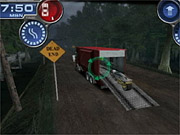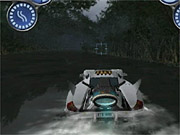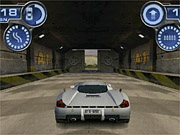Spy Hunter Preview
We a take long hands-on look at the Spy Hunter update from Midway and Paradigm.
Despite our initial apprehension about the potential quality of Midway's upcoming Spy Hunter remake, our recent prolonged exposure to it has yielded some pretty favorable impressions. While mention of the game's title definitely brings back memories of the original's sleek sit-down cabinet--complete with U-shaped wheel--spending time with the modern iteration makes it evident that Spy Hunter is definitely a worthy experience in its own right.

At its core, Spy Hunter is a car combat game, sans the element of competition. It retains the constant pace of the original, but it very deftly adds the level of complexity required to make a classic remake relevant. From a design standpoint, it's not unlike games like Ace Combat--behind the wheel of the G-6155 Interceptor, you'll tackle a diverse series of missions, including seek-and-destroy scenarios, the (heavily) armed escorting of defenseless vehicles, and everything in between. Its control scheme is definitely more suited to its interesting brand of "driving adventure" than, say, a Twisted Metal or Vigilante 8 game's would be--it's far less complex and entirely focused toward disabling enemies significantly weaker than you.
All your weapons are mapped to the shoulder buttons, as are the commands that allow you to cycle through your arsenal. Per the original blueprint, you have both offensive (machine guns and rockets) and defensive (oil slicks and smoke screens) devices at your disposal, and a set of shoulder buttons is assigned to each--L1 and L2 for cycling through your weapons and defensive devices and R1 and R2 for using them. Acceleration and braking are assigned to the X and square buttons, respectively, while hitting the triangle button calls up your high-tech rearview display. If you hit the X button twice in quick succession, you'll activate a handy turbo boost, though it takes several seconds to refresh between uses. The circle button seems to be a catch-all key, of sorts. In one of missions in the current demo, it deploys tracking bugs, and we suspect that it may used for a different function in every scenario, but its ultimate function has yet to be determined. The left analog stick is used for steering, and, when it's pressed in (L3 style), it also allows you to cycle through targets when you're armed with missiles. Finally, as per the original, the Interceptor is able to do its thing on both land and water. When you hit the water, it instantaneously transforms into a waterborne version of itself--in real-time, no less. The vehicle's controls are for the most part identical in both forms, though the responses the controls yield in water are suitably more deliberate.

One of Spy Hunter's major additions to the original formula is its use of a secondary extraction vehicle (SEV) as a dominant gameplay device. Essentially, a smaller vehicle within the Interceptor emerges when a certain damage threshold has been reached. As the Interceptor itself has two forms, so does the SEV. On land, it's a sleek motorbike, of sorts, while on water, it transforms into a sharp little Jet Ski. These secondary forms are a whole lot weaker--but also a great deal zippier--than the actual Interceptor. As you may have guessed, however, littered throughout the environments are red trucks that suit you up and rearm you, so your time in spent in the SEV's should just be transitory.
At this point, the control scheme is in very good shape. Everything reacts responsively, and the sense of control is, for the most part, amazing. The car occasionally seems to swing pretty wide when small swerves would have been more appropriate, but we have faith that everything will enjoy the requisite amount of tweaking before the game's final burn.
The scenarios included in the demo of Spy Hunter recently released by Midway do much to affirm many of our original theories about the game's layout. They're essentially multiobjective missions, with both primary and secondary objectives requiring completion. That didn't really come as a surprise to anyone, though. What did, however, was that Paradigm was able to imbue what are in effect strictly linear mission maps with a type of frenetic to-and-fro gameplay focus, more reminiscent of GoldenEye's mission structure than anything else. So while it's easy to think of the tracks as linear--and even more so when you consider that you'll be driving through them--the missions themselves have tuned out to be only as linear as the imaginations of the designers who dreamed them up. At this point, it's safe to say that Spy Hunter has some of the most cleverly designed maps ever to grace a vehicle-based game, outside of the deathmatch-arena context.

One mission in particular takes place in the jungles of Panama, and it manages to mix it up quite a bit. At its outset, you're escorting a cargo truck along a canopied dirt road that is heavily populated with enemies driving antique Ford pickups. For about two minutes, you have to fight off the enemy trucks on the relatively narrow road, and you have to watch your aim, lest you wind up blasting your own truck. You'll eventually get your truck to its extraction point--the edge of a settlement, alongside a long canal, where a helicopter awaits--and from there, it's off to both land and water. Your main objective is to disable a number of the anti-Interceptor prototypes that the evil NOSTRA organization is in the process of engineering, and much of the mission's action revolves around locating them. As they're mainly located within the hulls of large ocean liners spread throughout the canal, you can expect to run through the course of the map, back and forth, several times. Secondarily, you have to activate all the "satcoms" in the mission area. Satcoms are small green spheres littered throughout the environments, and you activate them simply by driving into them. Without a doubt, satcoms are the closest that Spy Hunter's team comes to artificially extending gameplay via arbitrary methods; think of them as bonus tokens in platform games, only you're forced to collect them all in order to complete the mission. In any event, the mission's action seldom relents. Choppers, armored "bullies," and evil Jet-Skiers are constantly buzzing about, and the layout of the environment makes for much high-flying and narrow-sliding, and powerful loopy U-turns (upon which the game seems to thrive). You fly off the decks of ships and off the beds of trucks onto marvelously rendered, murky canal water, upon whose surface your Interceptor transforms fluidly into a craft only slightly clumsier than a water moccasin. And the mission's nine-minute time limit imposes an enjoyably frantic feel upon the whole endeavor.
Overall, Spy Hunter is shaping up to be quite a welcome surprise. Our only quibble is that it would be great to have the role of the defensive devices increased, as now, using them in lieu of your guns is downright silly. One of the game's 14 missions might just allow for this, though, so we're not discounting the possibility just yet.

The game is currently about three-quarters of the way done, and it's looking very nice and playing very smoothly. We're expecting to see an updated build sometime this week, though, so keep your eyes peeled for the inevitable update. Spy Hunter is currently slated for an October release.
Got a news tip or want to contact us directly? Email news@gamespot.com
Join the conversation